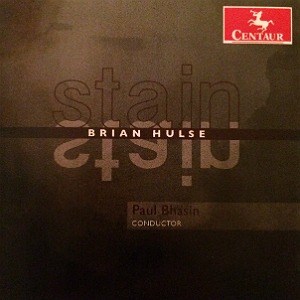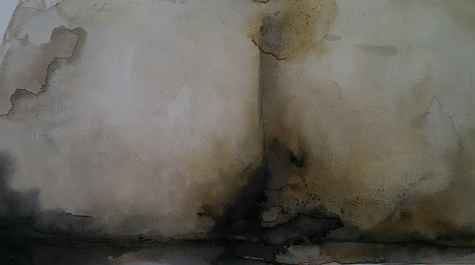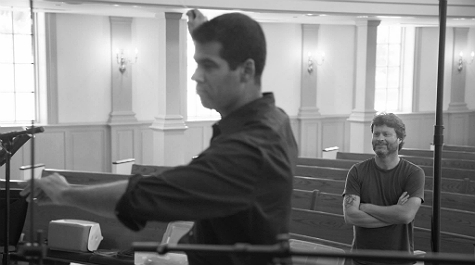Art, opera unite in music professor's latest album
The word “stain” connotes many things to the average person, most of them negative, and none of them related to music. Brian Hulse, however, has turned these connotations on their head in his latest album, "Stain."
A collaboration between Hulse, associate professor of music theory and composition, and former William & Mary music professor Paul Bhasin produced by Centaur Records, "Stain" is a collection of Hulse’s compositions performed largely by members of the William & Mary community and centered on the concept of stain.
“'Stain' is a thematic album where everything that went into it revolved around the idea of a stain,” Hulse said. “There’s a certain aspect of music that allows it to create different planes of time and memory, and all of these things are leaving a mark — the way that you actually see the world is completely infused with memories. These memories are like patches, like stains: they mean different things and have different kinds of impacts.”
Although much of the album’s music has a somber tone, the notion of stain is more complex than mere sadness.
“It isn’t a sad concept, although it sounds that way. It has a distinct nostalgia to it because we are thinking of this music as mostly in the past,” Hulse said, noting that the pseudo opera scenes on the album evoke qualities of pleading about things that cannot be changed.
Hulse did not originally intend to create an album of restless, contemplative music, which is itself a stark contrast from the tone of his first album, "Pseudosynthesis." That album was inspired by a trip Hulse took to Eastern Mediterranean University in Cyprus and has a notably Mediterranean feel: he describes the album as “open, vivacious and witty.”
" Stain," in contrast, soon developed an aura to match its title.
Stain," in contrast, soon developed an aura to match its title.
“I didn’t set out to write this melancholy, dark music as some sort of broad theme. It’s just what gathered around the word ‘stain’ and the philosophical thoughts about that — and, of course, the painting.”
This painting — a work by Elizabeth Mead, art and art history department chair and Class of 1963 Term Distinguished Associate Professor of Art and Art History — proved to be the key to the work. Unlike most albums, whose cover art is selected to match the music’s tone, the cover art for "Stain" determined the album’s musical direction.
“I had met and come to know Elizabeth Mead’s work since joining the faculty here, and we developed a kind of rapport. I love her work, it’s so powerful to me,” Hulse said. “So the first idea for this album was the idea of working with Elizabeth to come up with art for the cover.”
It did not take long for Mead’s art to strike Hulse with inspiration.
“We spent some time in her office going through some of her work, and I saw the piece, took a photo of it on my phone, and it took off from there,” he said. “This art became about finding the right idea to wrap other ideas around, something that allows a work of art to be meaningful alongside a piece of music and a thought.”
With the idea in mind for his compositions, Hulse next had to determine who would bring his music to life. He didn’t have to look far.
“It just seemed natural to record the album at William & Mary since Paul and I were working together,” Hulse said. “Our faculty are the top players in Richmond and Norfolk — the very top. In essence, why go beyond William & Mary? We had everything we needed and some. Plus, we wanted to do something that was about William & Mary, something produced through all these different talents and abilities that people have at this College to create something expressive and lasting.”
Nor did Hulse and his team have to travel far to find an excellent recording studio: They simply crossed Jamestown Road from Ewell Hall to Williamsburg Presbyterian Church.
“I don’t think the church was designed to be an especially perfect space for recording, but it works really well,” Hulse said. “There’s very low room noise, a nice big space, and the organ is gorgeous.”
Having now traversed the disparate worlds of lively Mediterranean-inspired tunes to the melancholy nostalgia of "Stain," Hulse’s next major project is in a decidedly different vein: he’s writing a book. Even though he’s not transitioning directly into a new album, Hulse is continuing to explore new approaches to music.
Nowhere is this creativity better displayed than in “Widget,” a new composition premiering later this fall in a performance by percussion ensemble Clocks in Motion.
“‘Widget’ is a piece for four percussionists, but in twelve different settings. All the percussionists are moving to different instruments during the piece. It’s all very dynamic, fun and totally different from the mood and character than 'Stain.'”
Although Hulse is not sure what direction his next album will ultimately take, “Widget” likely will provide a few clues.
“‘Widget’ is a perfect piece to show where I’m headed right now, as it’s my most recent piece. It’s a lot more about ideas, novelty, and joy. That’s where I see my music going.”
Clocks in Motion will be performing “Widget” on Nov. 15 at 7:30 p.m. in the Williamsburg Library Theatre, located at 515 Scotland St. Admission is free.
















